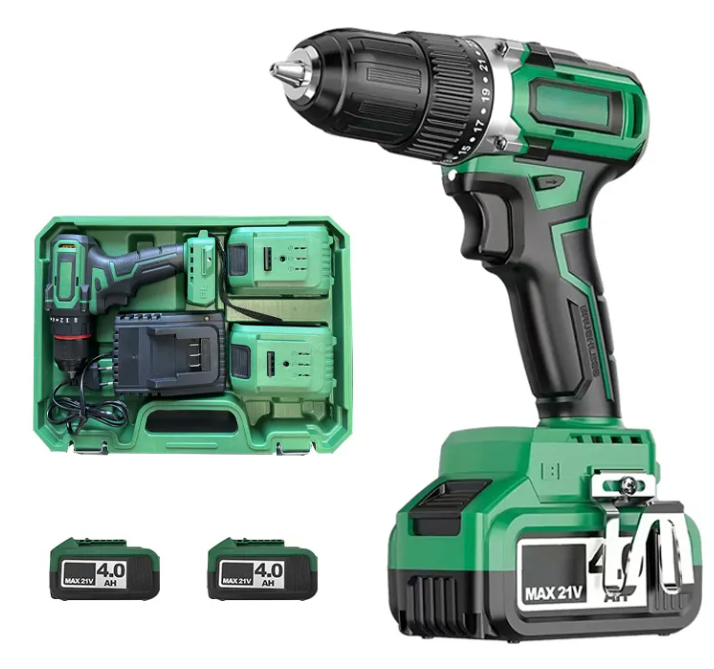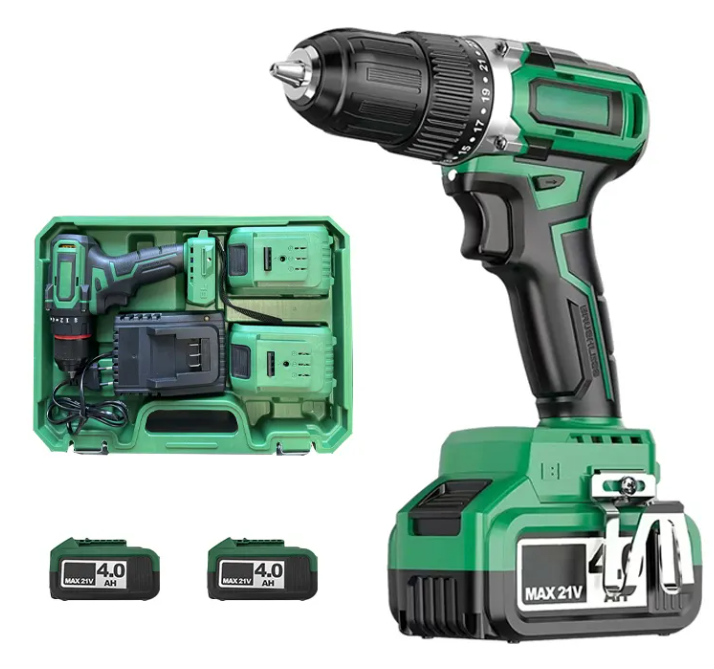Convient Tool Cordless Drill Power Electric Drill
An electric drill is a versatile power tool used for drilling holes in various materials and for driving screws. Here’s an overview of its features, types, uses, and safety tips.
Key Features
Power Source: Can be corded (plugged into an outlet) or cordless (battery-operated).
Motor: Provides the power needed to rotate the drill bit.
Variable Speed: Allows adjustment of speed for different tasks, enhancing control.
Chuck Size: The part that holds the drill bit; common sizes include 1/4″, 3/8″, and 1/2″.
Torque Settings: Adjustable settings to control the amount of force applied, useful for driving screws.
Types of Electric Drills
Corded Drills:
Always powered by an outlet.
Generally more powerful and suitable for heavy-duty tasks.
Cordless Drills:
Battery-operated for portability.
Ideal for tasks where mobility is essential.
Hammer Drills:
Combines rotary drilling with a hammering action.
Effective for drilling into harder materials like concrete and masonry.
Impact Drills:
Provides bursts of high torque.
Great for driving screws and drilling into tough materials.
Common Uses
Drilling Holes: For various projects in wood, metal, plastic, and concrete.
Driving Screws: Efficient for assembling furniture or cabinetry.
DIY Projects: Essential for a wide range of home improvement and craft tasks.
Construction: Used on job sites for various drilling and fastening needs.
Safety Tips
Wear Safety Gear: Always use safety goggles to protect your eyes from debris.
Secure Workpieces: Use clamps to hold materials in place while drilling.
Check for Obstructions: Ensure there are no wires or pipes behind the surface you’re drilling.
Use Correct Bits: Select the right drill bit for the material and task.
Maintain Control: Keep a firm grip and maintain control, especially at higher speeds.
Conclusion
An electric drill is an essential tool for both professionals and DIY enthusiasts. Its versatility and ability to handle various tasks make it a must-have in any toolbox. Whether you’re drilling holes or driving screws, understanding its features and safety precautions can enhance your efficiency and effectiveness.

Safe operation
1. Preparation Before using the hand drill, make sure you understand the size and location of the required hole so that you can choose the right drill bit. Check that the power cord of the hand drill is intact and the battery is fully charged. Wear appropriate protective gear such as goggles, earplugs and gloves.
2. Holding the hand drill The correct holding method can improve operating efficiency and reduce the risk of injury. Normally, we recommend holding the hand drill in the following way: hold the handle of the hand drill with one hand and gently hold the drill bit on the spindle with the other hand. Make sure that the drill bit is kept at a certain distance from the surface of the workpiece to prevent the drill bit from overheating or damage.
3. Choose the right drill bit Choose the right drill bit according to the required hole size and material hardness. Carbide drill bits are suitable for metal and hard wood, while fiberglass drill bits are suitable for plastic and wood. When installing the drill bit, make sure that the drill bit is aligned with the spindle hole and tighten it gently with a wrench.
4. Control the speed The speed of the hand drill can be achieved by adjusting the power switch or voltage. When using the hand drill, be sure to select the appropriate speed to avoid damage to the equipment or injury to personnel due to excessive speed. Different speed settings can be used for drilling requirements of different materials. A higher speed can be selected for metal processing; while a lower speed should be selected for wood and plastic processing.
5. Keep the work area clean When using the hand drill, please ensure that the work area is clean and tidy to avoid accidents caused by accumulation of debris. Clean the heat dissipation holes and fans of the hand drill regularly to ensure the normal operation of the equipment.
Electric drill maintenance tips 1. Replace the battery regularly Hand drills usually use batteries as a power source. In order to ensure the normal operation of the equipment, it is recommended to check the battery power every once in a while (such as three months) and replace new batteries as needed. Clean the battery contact points regularly to improve the conductivity. 2. Maintain the spindle The spindle is the core component of the hand drill, which is responsible for transmitting torque and driving the drill bit to rotate. In order to extend the service life of the spindle, it is recommended to clean the dust and rust on the spindle regularly, and apply an appropriate amount of lubricating grease to avoid using the hand drill in an environment with high temperature, high humidity or excessive wear. 3. Check the screws and fixtures. Whether the fixing screws and fixtures of the hand drill are loose or damaged directly affects the stability and safety of the equipment. During use, the status of these parts should be checked regularly. If any abnormality is found, they should be replaced or repaired in time. 4. Avoid excessive wear. Long-term uninterrupted use of the hand drill may cause excessive wear of the spindle and bearings, thereby reducing the performance and life of the equipment. During use, pay attention to reasonably arrange working time and rest time to avoid excessive fatigue. Correct use of the hand drill and regular maintenance are the key to ensuring the safe and efficient operation of the equipment. I hope this article provides you with some practical suggestions and hopes to help you use your hand drill.

